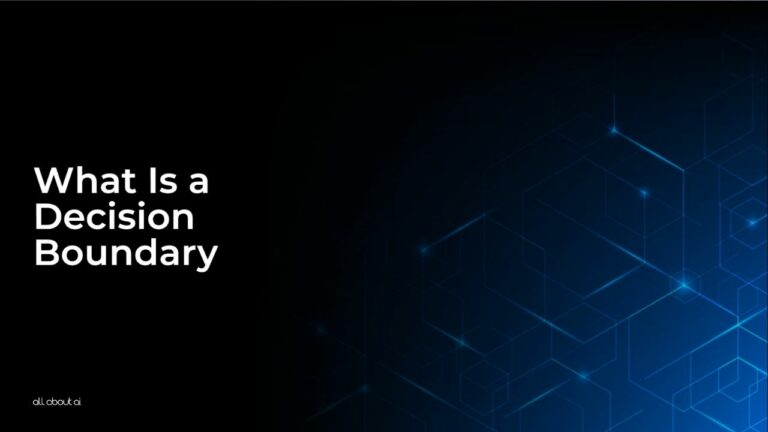What is a decision boundary? In the context of artificial intelligence (AI), a decision boundary is a hypersurface that partitions the underlying feature space into two or more classes. This boundary is formed based on the learning algorithm’s criteria, and it is used to classify new data points based on their features.
Eager to learn more about decision boundaries and their use in AI? Read this comprehensive article authored by the professionals at All About AI.
Examples of Decision Boundary
Image Classification Systems: Modern AI systems in image recognition use decision boundaries to categorize images. For example, a system can differentiate between images of cats and dogs by analyzing features like shape, size, and texture, setting a boundary based on these characteristics.
Financial Fraud Detection: AI algorithms in banking use decision boundaries to identify fraudulent transactions. By analyzing spending patterns and unusual account behavior, these systems can flag potential fraud, distinguishing it from regular transactions.
Voice Recognition Software: In voice recognition, decision boundaries help distinguish between different speakers or speech patterns. For instance, AI analyzes various aspects of speech like pitch, tone, and accent to accurately identify and understand different users or commands.
Market Segmentation Tools: AI in marketing employs decision boundaries to segment and classify customers into different groups based on purchasing behavior, preferences, and demographics, enabling personalized marketing strategies.
Use Cases of Decision Boundary
Automated Customer Support: AI chatbots use decision boundaries to understand and categorize customer queries. Based on the language and context of the query, the system determines the nature of the issue and routes it to the appropriate channel.
Predictive Maintenance in Manufacturing: AI systems predict equipment failures by establishing decision boundaries around normal operating conditions. Deviations from these conditions signal potential issues, enabling proactive maintenance.
Healthcare Diagnosis: AI in healthcare uses decision boundaries to diagnose diseases from medical images. By analyzing patterns in X-rays or MRI scans, these systems can differentiate between healthy and diseased tissues.
Traffic Management Systems: In smart cities, AI uses decision boundaries to optimize traffic flow. By analyzing traffic patterns, these systems can predict congestion and adjust traffic signals accordingly to reduce delays.
Pros and Cons
Pros
- Decision boundaries in AI allow for precise and efficient classification of data, enhancing accuracy in various applications like image and speech recognition.
- These boundaries adapt to new data, ensuring continuous learning and improvement in AI models, making them more robust and effective over time.
- They provide a clear visualization of how an AI model makes decisions, offering valuable insights into the model’s behavior and performance.
- Decision boundaries are versatile and can be applied to diverse fields, from healthcare to finance, enabling tailored solutions to complex problems.
Cons
- Establishing accurate decision boundaries can be challenging in complex datasets with overlapping or non-linear features, potentially reducing the model’s accuracy.
- Overfitting is a risk, where the model becomes too tailored to the training data, losing generalizability to new, unseen data.
- The complexity of defining decision boundaries increases with the number of features and classes, requiring more computational resources and potentially longer processing times.
- Misinterpretation of decision boundaries can lead to incorrect assumptions about the model’s decision-making process, especially in high-stakes applications like medical diagnoses.
FAQs
What are the types of decision boundaries in AI?
Decision boundaries in AI can be linear or non-linear. Linear boundaries are straight lines (or planes in higher dimensions) that separate classes, while non-linear boundaries are more complex, using curves or irregular shapes to classify data.
How does a decision boundary affect model accuracy?
The accuracy of a decision boundary directly impacts the model’s performance. A well-defined boundary accurately classifies data, resulting in high accuracy. Conversely, a poorly defined boundary leads to misclassification and lower accuracy.
Can decision boundaries be visualized?
Yes, decision boundaries can be visualized, especially in lower-dimensional spaces. This visualization helps in understanding how an AI model classifies different data points, providing insights into its decision-making process.
How do decision boundaries work in multi-class classification?
In multi-class classification, decision boundaries separate multiple classes within the feature space. Each boundary defines the limits between different classes, enabling the model to classify each data point into one of the multiple categories.
Key Takeaways
- A decision boundary is a hypersurface separating different classes in AI models.
- They are crucial in applications like image classification, fraud detection, and voice recognition.
- Properly defined boundaries enhance model accuracy and adaptability.
- Visualizing these boundaries offers insights into the AI model’s decision-making.
- Complexity and risk of overfitting are challenges associated with decision boundaries.
Conclusion
A decision boundary in the context of artificial intelligence and machine learning is a conceptual line or surface that separates different classes within a dataset. It’s the result of an algorithm’s attempt to categorize data points based on their features. The effectiveness of a decision boundary is crucial for the accuracy of a model. A well-placed decision boundary will correctly categorize new data with high precision, while a poorly defined boundary can lead to misclassification and errors.
This article explored the question, “what is a decision boundary,” focusing on its use in AI. If you’re looking to improve your understanding of the wider world of AI, read the other articles in our AI Knowledge Base.





